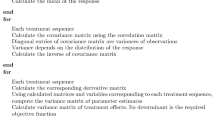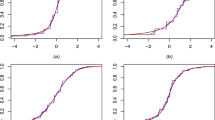Abstract
This paper considers how to detect influential observations in crossover models with random individual effects. Two influence measures, the delta-beta influence and variance-ratio influence, are utilized as tools to evaluate the influence of the model on the estimates of mean and variance parameters with respect to case-weighted perturbations, which are introduced to the model for studying the ‘influence’ of cases. The paper provides explicit expressions of the delta-beta and variance-ratio influences for the general two-treatment balanced crossover models when the proposed decompositions for the perturbed models hold. The influence measures for each parameter turn out to be closed-form functions of orthogonal projections of specific residuals in the unperturbed model.
Similar content being viewed by others
References
R. Haining, “Diagnostics for Regression Modeling in Spatial Econometrics”, J. Reg. Sci. 34, 325–341 (1994).
J. Li, Regression Diagnostics for Complex Survey Data: Identification of Influential Observations, Ph.D. Thesis (Univ. Maryland, College Park, 2006).
K. De Witte and R. Marques, “Influential Observations in Frontier Models, a Robust Non-Oriented Approach to the Water Sector”, Ann. Oper. Res. 181, 377–392 (2010).
B. Jones and M. Kenward, Design and Analysis of Cross-Over Trials (Chapman & Hall, Boca Raton, 2003).
J. E. Grizzle, “The Two-Period Change-Over Design and Its Use in Clinical Trials”, Biometrics 21, 467–480 (1965).
M. Putt and V. M. Chinchilli, “A Mixed Effects Model for the Analysis of Repeated Measures Cross-Over Studies”, Statist. Med. 18, 3037–3058 (1999).
K. C. Carrière and R. Huang, “Crossover Designs for Two-Treatment Clinical Trials”, J. Statist. Plann. Inference 87, 125–134 (2000).
Z. Yan and C. Locke, “Crossover Designs for Comparing Test Treatments to a Control Treatment when Subject Effects are Random”, J. Statist. Plann. Inference 140, 1214–1224 (2010).
A. S. Hedayat and W. Zheng, “Optimal and Efficient Crossover Designs for Test-Control Study when Subject Effects are Random”, J. Amer. Statist. Assoc. 105, 1581–1592 (2010).
R. Christensen, L. Pearson, and W. Johnson, “Case-Deletion Diagnostics for Mixed Models”, Technometrics 34, 38–45 (1992).
J. Haslett and D. Dillane, “Application of ‘Delete = Replace’ to Deletion Diagnostics for Variance Component Estimation in the Linear Mixed Model”, J. Roy. Statist. Soc. Ser. B, Statist. Methodol. 66, 131–143 (2004).
L. Shi and G. Chen, “Local Influence in Multilevel Models”, Canad. J. Statist. 36, 259–275 (2008).
R. D. Cook, “Assessment of Local Influence”, J. Roy. Statist. Soc. Ser. B, Statist. Methodol. 48, 133–169 (1986).
R. J. Beckman, C. Nachtsheim, and R. D. Cook, “Diagnostics for Mixed-Model Analysis of Variance”, Technometrics 29, 413–426 (1987).
E. Lesaffre and G. Verbeke, “Local Influence in Linear Mixed Models”, Biometrics 54, 570–582 (1998).
H.T. Zhu and S. Y. Lee, “Local Influence for Incomplete Data Models”, J. Roy. Stat. Soc. Ser. B. Statist. Methodol. 63, 111–126 (2001).
H. T. Zhu, S. Y. Lee, B. C. Wei, and J. Zhou, “Case-Deletion Measures for Models with Incomplete Data”, Biometrika 88, 727–737 (2001).
V. Chen and V. M. Chinchilli, “A Generalized Correlation Coefficient for the General Two-Treatment Crossover Design”, Comm. Statist. Theory Methods 39, 2063–2080 (2010).
C. Hao, T. von Rosen, and D. von Rosen, “Local Influence Analysis in AB-BA Cross-Over Designs”, Scand. J. Statist. doi: 10.1111/sjos.12090 (2014)
T. H. Szatrowski, “Necessary and Sufficient Conditions for Explicit Solutions in the Multivariate Normal Estimation Problem for Patterned Means and Covariances”, Ann. Statist. 8, 802–810 (1980).
E. Demidenko and T. A. Stukel, “Influence Analysis for Linear Mixed-Effects Models”. Statist. Med. 24, 893–909 (2005).
K. Afsarinejad and A. S. Hedayat, “Repeated Measurements Designs for a Model with Self- and Simple Mixed Carryover Effects”, J. Statist. Plann. Inference 106, 449–459 (2002).
R. Kershner and W. Federer, “Two-Treatment Crossover Designs for Estimating a Variety of Effects”, J. Amer. Statist. Assoc. 76, 612–619 (1981).
K. C. Carrière and G. C. Reinsel, “Investigation of Dual-Balanced Crossover Designs for Two Treatments”, Biometrics 48, 1157–1164 (1992).
D. A. Belsley, E. Kuh, and R. E. Welsch, Regression Diagnostics: Identifying Influential Data and Sources of Collinearity (Wiley, Hoboken, 2004).
S. R. Searle, Matrix Algebra Useful for Statistics (Wiley, New York, 2006).
C. Hao, T. von Rosen, and D. von Rosen, “Influence Analysis in Two-Treatment Cross-Over Designs with Special Reference to the ABBA/BAAB design”, Report 2011-2 (Stockholm University, Department of Statistics, 2011).
SAS Institute Inc., SAS/STAT® 9.3 User’s Guide (SAS Institute Inc., Cary, NC, 2011).
O. Schabenberger, “Mixed model influence diagnostics”, in Proc. 29th Annual SAS® Users Group International Conference (2005), Paper 189-29. Available from http://www2.sas.com/proceedings/sugi29/toc.html.
R. D. Cook, “Detection of Influential Observation in Linear Regression”, Technometrics 19, 15–18(1977).
Author information
Authors and Affiliations
Corresponding author
About this article
Cite this article
Hao, C., von Rosen, D. & von Rosen, T. Explicit influence analysis in two-treatment balanced crossover models. Math. Meth. Stat. 24, 16–36 (2015). https://doi.org/10.3103/S1066530715010020
Received:
Accepted:
Published:
Issue Date:
DOI: https://doi.org/10.3103/S1066530715010020
Keywords
- delta-beta influence
- explicit maximum likelihood estimate
- mixed linear model
- multiple-period crossover design
- perturbation scheme




